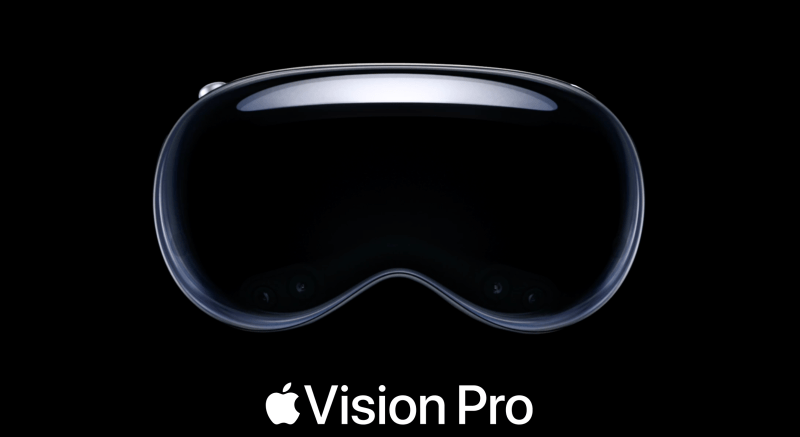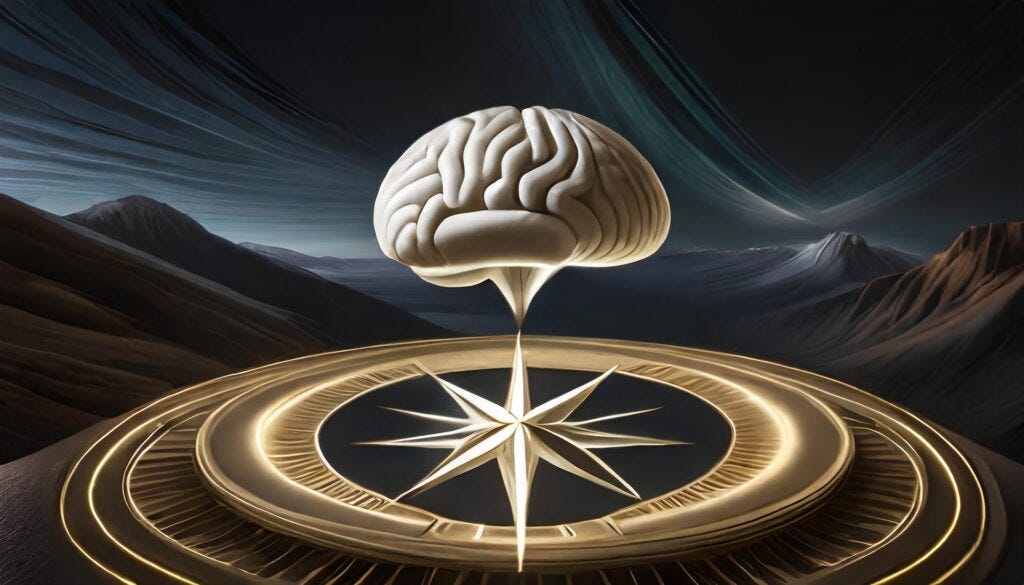#33: 🥽 Spatial Computing Is Here And You're Not Ready For It 👀
The Future Of Computing & The Skill Needed To Control It 👀

Spatial computing is here 🥽
Yesterday, Apple released the Vision Pro, a spatial computer that has been carefully crafted to completely change the way we interface with technology.
Apple has been building to this moment for 17 years, with the first Vision Pro related patent filed in 2007, the year of the iPhone (which has X (twitter) users saying that the Vision Pro was Steve Jobs' "one more thing").
The old way of mouse and keyboard are in the past. The new way is merely to use your eyes and fingers.
But there is a catch: you must be able to control where your eyes are looking. You must have awareness of your attention and the ability to direct it.
Unfortunately, much of our current computing world is literally the opposite of encouraging attention control by the end user. Algorithms optimize the mining of attention so that advertising dollars go up.
when the product is free, you are the product
Welcome to web2, a world built on the attention economy of its users.
What does that mean for a world that is shifting to eye-control as the interface of computing?
It means you must begin recalibrating your connection with the Internet and technology as a whole.
The current world is one that, if we allow it, will pave the way for disaster with the eye-control computing interfaces of spatial computers.
Algorithms have been trained for the past 17 years to know exactly how to keep your attention looking at precisely where they want you to look so that you stay on this platform rather than that platform.
To make way for a better future, we must rethink our interaction with algorithms (inhuman entities) and the social platforms that support them.
All is not lost. We do not have to give into the algorithmic control of the past and present.
To go forward, we can project the anti-algorithmic technology we have now into the world of spatial-computing.
Welcome to web3.
Recalibrating Recap
Welcome to Recalibrating! My name is Callum (@_wanderloots)
Join me each week as I learn to better life in every way possible, reflecting and recalibrating along the way to keep from getting too lost.
Thanks for sharing the journey with me ✨
Last week, we touched on digital identity, personal brands, and the future of the creator economy. For more information on these topics, check out my latest YouTube video:
If you watch, I would absolutely love if you could comment your favourite or most interesting part 😊 I'm working on the next videos and your feedback is incredibly helpful.
This week, we are going to continue by discussing what it means to link identity across the Internet through blockchain as part of web3. I'll also touch on how this system helps with the algorithmic attention issues we are facing and how to future proof yourself for the advent of spatial computing and the next iteration of the Internet.
The Bigger Picture Of Attention & Spatial Computing
Since relatively few people have access to the Vision Pro so far (only in the U.S.), I thought I would begin explaining my vision for the future of computing and the skills needed to enter and build that world responsibly.
The true impact of spatial computing cannot be predicted. It is a revolutionary shift in the current virtual reality/augmented reality (VR/AR) landscape.
However, we can know how, based on the patents that have been filed for the Vision Pro, Apple predicts the operation of computing to work in the future. Hint: it involves truly controlling your attention, a diminished resource in today's society.
If you are not mindful of your attention, you will find this new world a difficult one to control without having it control you.
The best way to avoid being controlled by attention-mining algorithms is, in my opinion, to avoid them entirely.
To do that, we must leave the realm of web2 behind.
History Of The Web
Web3 is so called because it is the third iteration of the Internet as we know it.
Web3 is another layer on the internet, an ownership layer. This additional layer runs on blockchain to provide scarcity to digital assets, a previously difficult or impossible task.
To better understand web3, let's take a look back at the history of the web to see where we've come from.
READ
Web1 was the beginning of the internet. Readable documents were uploaded online and users could read the content they posted. This content was not engageable.
In other words, I could not easily comment on a blog post or have a conversation with someone on a website. The internet was a place of reading, a one-way street of information flow.
READ + WRITE
Web2 developed as the Internet became more engageable. Websites began to allow people to comment on posts, message each other, and upload their own content. In other words, the Internet was now a two-way street of information flow.
I could read content presented online and could write to the Internet by adding my own content (e.g., photos or writing).
This is the web that we are currently using, for the most part. The problem is that the data and information shared online through centralized platforms are owned by the platforms themselves, not the users, and controlled by algorithms.
READ + WRITE + OWN
Web3 takes web2 one step further by adding the missing ownership layer.
Instead of having a centralized platform own the digital assets its users are creating, the users themselves own the digital assets and can control how they are transferred and used.
Web3 allows for decentralized ownership online, rather than the centralized hubs of web2.
Web3 allows one to truly own a digital file and demonstrate that ownership online by way of blockchain.
Before I get into why this matters for the future of spatial computing and the Internet as we know it, I'll give a bit more context into how blockchain works.
Blockchain And Web3
Blockchain is a decentralized ledger system that enables the tracking of digital information online.
Imagine I have a digital asset (cryptocurrency or NFT) that I want to sell to someone else. To get this asset, I must have created (minted) or purchased the digital asset myself.
This initial purchase created a transaction block on a blockchain. This block recorded the date of my purchase, who I purchased it from, and what I got by purchasing it.
When I sell the digital asset to another person, that means that a new transaction block is created. This new block is linked to the previous block I created and contains the title details (ownership details) of the new owner.
Over time, as assets are created, bought, sold, and traded, more and more blocks get added to the chain. Blockchain.
It is important to recognize that it is not necessarily the asset itself that is being changed, merely the reference to the asset and who owns it that is changed when new blocks are added.
If any of this is confusing (it took me a long time to grasp it) I have more resources available here:
Analogy: Certificate of Authenticity
This certificate of authenticity is used for all kinds of rare items (books, baseball cards, paintings, etc.)
The value of the work increases because of its authenticity, but also because of the implied scarcity. There is only one Mona Lisa, which makes it ultra-rare and effectively priceless.
Baseball trading cards have limited prints of certain players each year, which increases their relative value compared to the more common cards. Pokemon cards have limited supply of the rarer Pokemon, which makes them more valuable than the common Pokemon.
The same principles apply to digital assets. The core issue, however, is that digital assets can be screenshot or right-click-saved. They can be copied by anyone, anywhere, anytime. Physical goods can be replicated, but it's harder to fake the authenticity. With digital assets, the copy is often identical to the original, making it easy to steal.
Effectively, this meant that traditional digital assets could not have scarcity. This lack of scarcity means that the potential value is lower compared to physical assets. In web2, no one can prove who owns what and there are potentially millions of everything.
Enter blockchain.
Blockchain enables the creation of a digital certificate of authenticity associated with a single digital asset. This certificate of authenticity means that digital files can be made scarce.
This is a HUGE deal.
I can now create a digital asset (e.g., NFT) of my photo online, by creating a block on a blockchain. This photo becomes associated with the specific block that was created and with the person that created it. There is ONLY ONE of these blocks. Scarcity ⬆+1.
If someone screenshots the block, they can't do anything with it. If they screenshot the photo, they can replicate it all they want, but the copies do not come with the block of authenticity.
The digital asset becomes uniquely & verifiably associated with the identity that created it.
Authentically Linking Digital Identity
The identity associated with the creator of the block on the blockchain is transparent to everyone in the form of a wallet address. The wallet holds the private key of the identity. The key is used to sign transactions to create new blocks. No one else has this key.
The wallet can be associated with a name, such as through the Ethereum Naming Service (ENS). This association means every time that wallet signs a transaction (creating, buying, selling or trading a digital asset), the address of the wallet and corresponding name will appear on that block FOREVER.
Furthermore, the wallet ID is not associate with a platform like Google, Facebook, Apple, Meta, YouTube, TikTok, Snapchat... you get the picture. Instead, the wallet ID is self-sovereign. Owned by you (unless you are using a centralized exchange to hold your assets, this is what caused people to lose money in the FTX scandal - not your keys, not your crypto).
The identity is independent of any one platform.
Since the same wallet is used across all platforms, you only need one "account" for all things blockchain (almost, it may vary depending on the blockchain but we'll get into that later).
Effectively, the single wallet identity is linked across all of web3.
For example, I have my ethereum wallet linked to the ENS "wanderloots.eth". Every time I create an NFT or move cryptocurrencies around with this wallet address, everyone can see that wanderloots is the one who signed the transaction.
NO ONE CAN FAKE THIS.
No matter what platform I connect my wallet to in web3, all of my digital assets associated with wanderloots.eth are displayed (I have other wallets for security purposes, but that's a more complicated issue for another day).
I have a single identity that bypasses every algorithm and sign-in request.
Or it would, if we weren't still operating mostly in web2.
The Algorithmic Attention Problem
Back to the issue at hand: attention and the future of spatial computing.
Web2 currently operates using recommendation algorithms that mine your attention for ad revenue. This is referred to as the attention economy or surveillance capitalism.
Social media ushered in the age of sharing and engaging with others online (web2). However, this age is not one humans were physically or mentally prepared for.
With everyone, everywhere, creating and sharing information all at once, our senses are overloaded with information.
These social media platforms are centralized mining hubs, extracting the attention of their users in exchange for ad revenue.
To optimize attention mining of their users, social media platforms created algorithms. These algorithms often (if not always), have a single purpose: maximize profits by holding your attention as long as possible. They are puppet masters and you are the puppet.
when the product is free, you are the product
In theory, they should be showing you what you want to see. YouTube's algorithm is based on "user satisfaction". However, these algorithms are not human. They do not have your mental health in mind. They do not care if you sit there scrolling for 5+ hours each day until you are anxious and depressed.
TikTok is famous for "reading the minds" of their users (also interesting that "user" is a term for both social media platforms and people addicted to drugs). The TikTok algorithm is so good at predicting what you want to see, that you can be stuck in a scroll for hours without realizing it.
Even though you want to see it, perhaps you shouldn't.
Perpetually being shown your desires comes at a cost: your attention.
Attention Control Interface For Spatial Computing
If we continue to allow algorithms to control what we see and do online, our attention is doomed, right at the time of technological development when we will need it the most.
Apple has filed over 5000 patents for the Vision Pro. Among these patents are a series of neurotechnological patents that were worked on by Sterling Crispin, who tweeted publicly about his involvement a few months ago.
Among many incredible features, Sterling mentioned:
Effectively, when you are about to click on something, your pupil reacts because of your expectation. If you expect something to happen, it will happen.
Imagine this technology used for researching, editing, writing. Anything on your computer, you will no longer need to use a keyboard or mouse, you can merely use your eyes to click on what you want, if you have the attention to do so.
Imagine this technology harnessed by algorithms that are trying to mine your attention for ad revenue.
Are you starting to see why your ability to control your attention is going to become a lot more important in the near future?
Technology itself is neither good nor bad. It's how YOU use it that determines its morality.
A Post-Platform World
Algorithms can be incredibly useful. They will be used to track our health (both physical and mental), suggest content that we actually want to see, and in general build automation systems that will improve the quality of life for many people.
However, the current web2 way of algorithmically showing people content is wreaking havoc on attention and mental health, especially considering that negative information receives more shares and engagement than positive information, creating a perverse incentive for algorithms to share exaggerated and overly negative content.
The current web2 way is also not prepared for the onslaught of AI-generated content that is hitting the Internet now.
We need a better system, one where we are actually in control of what we see online.
Web3 enables the linking of identity across platforms, making it a post-platform system (platform independent).
People are able to subscribe and connect directly to the wallets of others, meaning that consumers are able to receive information directly from the creator, without needing to use a specific platform.
This direct creator-fan connection will open up a new world of curating information in a way that is algorithmically independent, while also providing identity verification systems to flag AI vs Human content.
Instead of relying on an algorithm to control what you see each day, you will be able to carefully curate your own custom feed that is directly connected to the creators you are interested in seeing.
Intentionally controlling what you see is the definition of having attention control.
By distancing yourself from algorithmic suggestions as a normal part of your day, you will be able to conserve your attention.
Proper control over your attention will become one of the most valuable skills you can ever develop when dealing with spatial computing systems that are controlled with that attention.
But technology is only part of the solution.
Mindful Attention

As a non-technological solution to the attention problem, the best way I have ever found to improve my attention is through mindfulness practice.
A lot of people think of mindfulness as some spiritual or religious practice, which to be fair, it can be depending on the person. However, I view mindfulness more as a philosophy. A way of living in the present with awareness of my self.
Every moment is an opportunity to respond mindfully or react mindlessly. If we are used to giving into our physiological reactions, we lose the ability to control our attention.
By practicing mindfulness regularly, we can learn to control our attention and respond instead of react.
If you start practicing now, perhaps you will be ready for the world of spatial computing that is going to heavily rely on your ability to control your own attention.
Perhaps you will learn to fight back in the war for your attention that is being fought almost every second of every day.
It's not too late.
You can always take a deep breath, and begin again.
Here's an introduction to mindfulness to get you started ✨
Next week
I hope this was a helpful introduction to web3 as a concept that will play a large role in the development of a sustainable and authentic Internet (metaverse).
Next week, we'll continue with the concepts of digital value as we explore the future of computing and the Internet.
P.S. If you are interested in learning how I build my digital mind (second brain) to help me process information and identify patterns to solve my problems, please consider upgrading your subscription to paid. Your support means more than you know 😌 ✨
Paid subscribers get full access to Worldbuilding, a practical counterpoint to the theories described in Recalibrating. You also get access to a private chat and bonus explanations exclusive to paying members 👀
If you are not interested in a paid subscription but would like to show your support, please consider buying me a coffee to help keep my energy levels up as I write more ☕️ 📝
Book of the week: Stolen Focus
One of my favourite books, Stolen Focus gives great insight into the current world of attention (or in reality, lack of it) and gives practical suggestions on how to improve your attention.



















Great summary of the social media addiction epidemic.
I'm understanding web 3 more all the time. Thankyou.